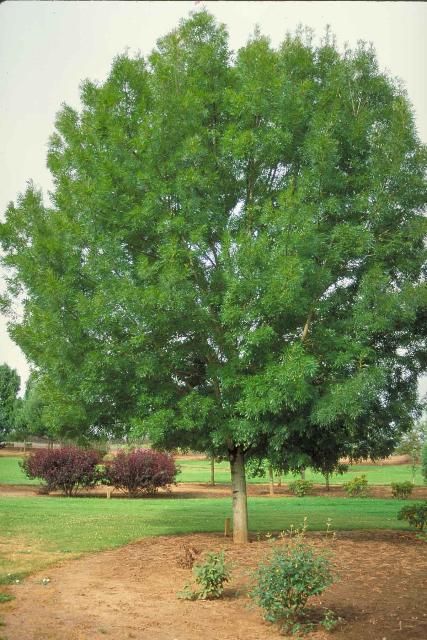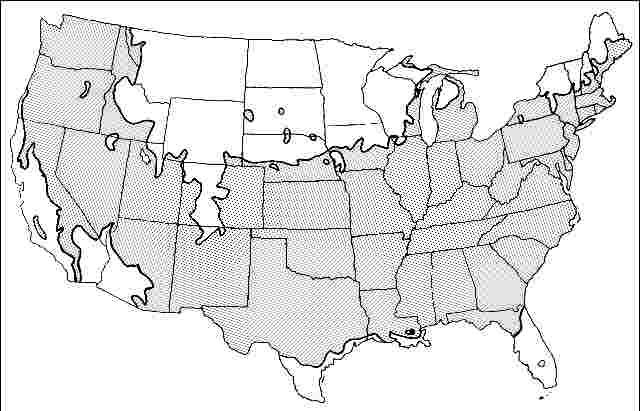Introduction
This Ash is a fine-textured, deciduous tree which is capable of reaching more than 80 feet in height but will more commonly be 40 to 50 feet tall with a 25 foot spread in a landscape, opening into a full, rounded canopy with age. Young trees are somewhat upright or oval. The lustrous, dark green leaflets create a light shade beneath the tree, making it well-suited for use as a large lawn specimen or shade tree. The leaves turn various shades of red to purple before falling in autumn.

Credit: Ed Gilman
General Information
Scientific name: Fraxinus oxycarpa
Pronunciation: FRACK-sih-nus ock-sih-KAR-puh
Common name(s): Raywood Ash, Claret Ash
Family: Oleaceae
USDA hardiness zones: 5A through 8B (Fig. 2)
Origin: not native to North America
Invasive potential: little invasive potential
Uses: specimen; shade; street without sidewalk; parking lot island 100-200 sq ft; parking lot island > 200 sq ft; tree lawn 4-6 feet wide; tree lawn > 6 ft wide; highway median
Availability: somewhat available, may have to go out of the region to find the tree

Description
Height: 40 to 50 feet
Spread: 25 to 30 feet
Crown uniformity: symmetrical
Crown shape: upright/erect, oval
Crown density: moderate
Growth rate: fast
Texture: medium
Foliage
Leaf arrangement: opposite/subopposite (Fig. 3)
Leaf type: odd-pinnately compound
Leaf margin: serrate
Leaf shape: lanceolate, elliptic (oval)
Leaf venation: pinnate
Leaf type and persistence: deciduous
Leaf blade length: 2 to 4 inches
Leaf color: green
Fall color: red, purple
Fall characteristic: showy
Flower
Flower color: unknown
Flower characteristics: not showy
Fruit
Fruit shape: no fruit
Fruit length: no fruit
Fruit covering: no fruit
Fruit color: no fruit
Fruit characteristics: no fruit
Trunk and Branches
Trunk/bark/branches: branches don't droop; not showy; typically one trunk; thorns
Pruning requirement: needed for strong structure
Breakage: resistant
Current year twig color: brown, gray
Current year twig thickness: thick
Wood specific gravity: unknown
Culture
Light requirement: full sun
Soil tolerances: clay; sand; loam; acidic; slightly alkaline; occasionally wet; well-drained
Drought tolerance: high
Aerosol salt tolerance: unknown
Other
Roots: not a problem
Winter interest: no
Outstanding tree: yes
Ozone sensitivity: unknown
Verticillium wilt susceptibility: susceptible
Pest resistance: resistant to pests/diseases
Use and Management
Reportedly maintains a central leader in youth but only after competing upright stems and branches have been removed. Be sure to space main lateral branches along the trunk and keep internal secondary branches intact to develop good branch structure. This allows each main limb to develop more fully and could increase durability by increasing taper along main branches. Do not allow major scaffold limbs to grow opposite each other on the trunk as this leads to poor structure and eventually could form a weak tree.
It should be grown in full sun and is moderately drought-tolerant once established. Although trees can tolerate wet sites, they will perform much better in well-drained conditions. Surface roots can be a problem on wet sites and on clay soil but they otherwise grow in a range of soil from sand to clay.
The cultivar `Raywood' has exceptionally striking red fall foliage and produces no seeds; it is often known as the `Claret Ash'. `Flame' turns deep burgundy in the fall similar to burgundy Sweetgum.
Pests and Diseases
No pests or diseases are of major concern, although possibly borers. This tree is reportedly resistant to anthracnose foliage disease and Ash lygusbug which attacks other Ashes.
